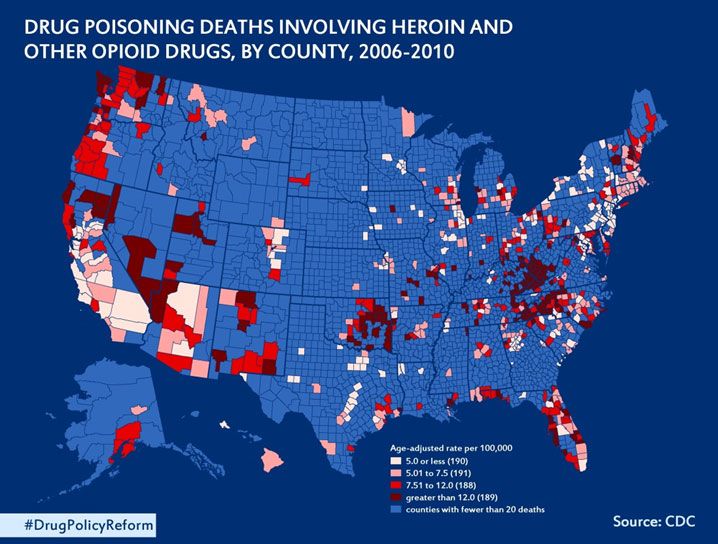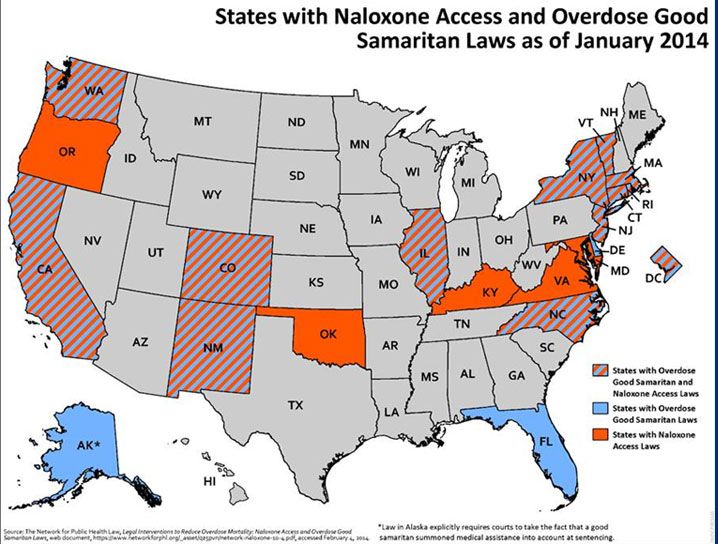Article
Heroin Addiction: A Chronic Disease, Like Any Other
Author(s):
In the US, 38,000 drug overdose deaths occur per year, and it is estimated that 75% are opioid-related. The good news is that addiction is a treatable disease. More in this discussion of opioid addiction, the use of naloxone, and Good Samaritan laws.
Figure 1. Drug poisoning deaths. Source: CDC

Figure 2. States with naloxone access. Source: Network for Public Health Law

What do Philip Seymour Hoffman, Kurt Cobain, John Belushi, Janis Joplin, and Jim Morrison have in common? If you answered that heroin either caused or contributed to their premature deaths, you are correct.1 However, you do not have to be artistic or famous to die from a drug overdose. In the US, 38,000 drug overdose deaths occur per year, and it is estimated that 75% are opioid-related.2 There were 3038 fatal heroin overdoses reported in 2010, a 45% increase from 2006.2
Additionally, it is estimated that nearly a quarter of users will suffer a near miss-an overdose from which a person nearly dies but is able to recover. Nationwide, for every fatal overdose, there are an estimated 25 to 50 near misses.3 Disturbingly, many overdose deaths and near misses go unreported, so these numbers may underestimate the actual number of individuals affected.4
Heroin abuse impacts Americans from all corners of our nation, despite minimal coverage by the mainstream media. Every day, around 100 Americans die from drug overdoses; about half involve opioid drugs.5 Few of these deaths make the evening news. However, if there is a car chase, gun violence, or an execution on death row, it may well be the leading story.
Sparse media coverage and the portraits painted in television and film have created a misconception that addiction affects only minorities, the poor, and those living in urban areas. In fact, the 5 states with the highest rates of overdose deaths in 2010 are not typically associated with having large urban or minority populations: West Virginia, New Mexico, Kentucky, Nevada and Oklahoma (Figure 1).6
Another common misconception is that much of the heroin found in the US comes from Afghanistan. Today, the US supply of illicit heroin comes primarily from South America and Mexico.7 In fact, the DEA has reported a 320% increase in the amount of heroin seized along the US-Mexican border between 2008 and 2013.8
Once heroin reaches the US, it is often cut with additional substances at local distribution centers. Therefore, every batch of heroin is unique. Subsequently, even an experienced user can accidentally take more of the drug than intended to get high. Recently, heroin has been found to be laced with fentanyl, an opiate that is 50 to 100 times more potent than morphine and 30 to 50 times more powerful than heroin. The user is often unaware that their supply stronger than usual, creating an extremely dangerous situation.
[[{"type":"media","view_mode":"media_crop","fid":"25362","attributes":{"alt":"Heroin, naloxone ","class":"media-image","id":"media_crop_1528061697904","media_crop_h":"0","media_crop_image_style":"-1","media_crop_instance":"2312","media_crop_rotate":"0","media_crop_scale_h":"0","media_crop_scale_w":"0","media_crop_w":"0","media_crop_x":"0","media_crop_y":"0","style":"margin: 5px;","title":" ","typeof":"foaf:Image"}}]]Some of the increase in accidental heroin overdoses has been attributed to these more potent batches of heroin.2 A consequence of taking a higher dose than intended is cessation of breathing, which can lead to death. The person who is overdosing can be given an opioid receptor antagonist, such as naloxone (Narcan) to reverse intoxication and overdose until they are able to receive medical attention. It can be injected into a vein or muscle or in some cases sprayed into the nose. Naloxone has reportedly been used to reverse more than 10,000 opioid overdoses since 2001.8
In April 2014, the Federal Drug Administration (FDA) approved the first naloxone auto-injector, Evzio.9 It can be administered by family members or caregivers to buy time until medical assistance arrives. The auto-injector goes into the muscle or under the skin and rapidly delivers a single dose of naloxone, equivalent to a single dose from a syringe. It provides verbal instructions and works similar to an automated defibrillator. The FDA recommends that families and caregivers of people known to abuse opioids practice with a device trainer before use is needed.
Ultimately, if the effects of heroin cannot be reversed, the user will need mechanical ventilation in a hospital or they will often die. Good Samaritan laws have been passed in 17 states and the District of Columbia; they grant limited immunity to drug users who seek help for someone who has overdosed. The goal is to encourage witnesses to call 911 or bring the person overdosing to a hospital for medical attention. The same number of states have expanded access to naloxone6 (Figure 2). Intoxication and overdose are a symptom of opioid addiction.
The more the public learns about heroin addiction, the more it becomes destigmatized and viewed as a chronic medical condition. Philip Seymour Hoffman was sober for over 20 years before he relapsed and an overdose took his life. His story reminds us that, like diabetes or high blood pressure, addiction requires lifelong treatment and relapse prevention. Increased media coverage and reporting of research findings would help to raise public awareness and decrease the number of overdoses.
This article began with the most well-known victims of heroin addiction. However, I hope it helps to raise awareness of how widespread the disease has become. Addiction impacts both the affluent and the poor. Addiction does not discriminate between those living in big cities or in the country. It causes problems for people of all races and nationalities. Addiction is an epidemic that affects all Americans. It is a treatable disease, which leads to preventable deaths. We must start to treat it as such.
Disclosures:
Dr Goldenberg is a psychiatry resident at Banner Good Samaritan Medical Center in Phoenix, Arizona. His blog, www.docgoldenberg.com, is dedicated to mental health and addiction topics.
References:
1. Drug-related deaths–notable celebrities. Drugs.com. http://www.drugs.com/celebrity_deaths.html. Accessed June 23, 2014.
2. Gorman S. Philip Seymour Hoffman death comes amid rise in heroin abuse, trafficking. Reuters. February 3, 2014. http://www.reuters.com/article/2014/02/04/us-seymourphiliphoffman-heroin-idUSBREA1304Z20140204. Accessed June 23, 2014.
3. Veeravagu A, Lober RM. Heroin: America’s silent assassin. The Daily Beast. February 3, 2014. http://www.thedailybeast.com/articles/2014/02/03/heroin-america-s-silent-assassin.html. Accessed June 23, 2014.
4. Publicker M. Jeremiad: heroin deaths go unnoticed. ASAM Magazine. January 29, 2014. http://www.asam.org/magazine/read/article/2014/01/29/jeremiad-heroin-deaths-go-unnoticed. Accessed June 23, 2014.
5. Office of National Drug Control Policy. Announcement to Medical Community. February 19th, 2014. http://pcssmat.org/wp-site/wp-content/uploads/2014/02/White-House-Article-100-people-die.pdf. Accessed June 23, 2014.
6. Ollove M. States combat alarming drug overdose deaths. USA Today. February 20, 2014. http://www.usatoday.com/story/news/nation/2014/02/20/stateline-drug-overdose-deaths/5637519/. Accessed June 23, 2014.
7. Office of National Drug Control Policy. 5 things to know about opioid overdoses. February 11, 2014. http://www.whitehouse.gov/blog/2014/02/11/5-things-know-about-opioid-overdoses. Accessed June 23, 2014.
8. Reuters Staff. U.S. Attorney General repeats call for naloxone training for law enforcement. Pharmacy Learning Network. March 10, 2014. http://www.pharmacylearningnetwork.com/articles/us-attorney-general-repeats-call-naloxone-training-law-enforcement. Accessed June 23, 2014.
9. Federal Drug Administration. FDA approves hand-held device to rapidly reverse opioid overdose (press release). April 3, 2014. http://www.fda.gov/NewsEvents/Newsroom/PressAnnouncements/ucm391465.htm. Accessed June 23, 2014.
















